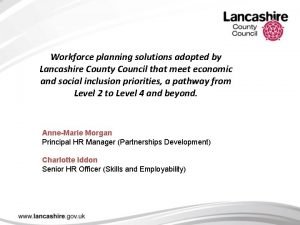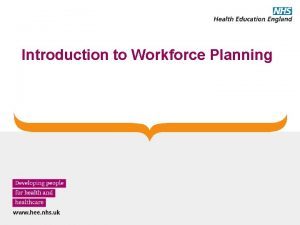Workforce Planning modelling and planning a changing workforce








- Slides: 8

Workforce Planning: modelling and planning a changing workforce Prof Stephen Birch, University of Manchester and Mc. Master University Dr Anne Mc. Bride, University of Manchester Dr Jon Gibson, University of Manchester Prof Matt Sutton, University of Manchester MUNROS is funded by the European Commission FP 7 programme, HEALTH-F 3 -2012 -305467 EC. Project co-ordinators Prof Bob Elliott, r. elliott@abdn. ac. uk and Prof Christine Bond, c. m. bond@abdn. ac. uk www. abdn. ac. uk/munros MUNROS is funded by the European Commission FP 7 programme www. abdn. ac. uk/munros

Modelling Health Workforce Change Traditional health workforce planning (HWP) models: • • apply demographic changes to existing levels of workforce supply or service utilisation needs of population, service responses and how those services delivered are ‘fixed’ Dynamic HWP model based on four elements (all change over time) • • size and characteristics of population being served levels of health risks and illness in population Services for addressing types and levels of health risks and illness Ways of delivering those services MUNROS data: which provider groups perform which tasks by care pathway For tasks that already done by both medical consultants and advanced practitioners (operating within SOP) what are the implications of reducing consultants time on these tasks? MUNROS is funded by the European Commission FP 7 programme www. abdn. ac. uk/munros

Contribution • Identifies implications of changing skill mix within care pathways • Enables long term planning of workforce requirements and training capacities • Responsive to changing needs of populations and evidence for addressing those needs MUNROS is funded by the European Commission FP 7 programme www. abdn. ac. uk/munros

Breast Cancer Pathway Mammograms (example) • Data: In Scotland, medical consultants (MC) in the MUNROS dataset who perform mammograms, perform them on 100% of the patients they see; Advanced radiographers (AR) in the MUNROS dataset who perform mammograms, perform them on 66% of patients that they see. • Estimates: If ARs were to be used for all mammograms: 1. What is the AR time required per hundred breast cancer patients diverted to ARs? 2. What is the MC time released by this substitution? MUNROS is funded by the European Commission FP 7 programme www. abdn. ac. uk/munros

Heart Disease Pathway Monitoring Disease – Electrocardiogram (example) • Data: In the Netherlands, medical consultants (MC) in the MUNROS dataset who perform electrocardiograms, perform them on 100% the of patients they see; Specialist nurses (SN) in the MUNROS dataset who perform electrocardiograms, perform them on 100% of patients that they see • Estimates: If specialist nurses were to be used for all electrocardiograms: 1. What is the specialist nurse time required per hundred breast cancer patients diverted to SNs? 2. What is the medical consultant time released by this substitution? MUNROS is funded by the European Commission FP 7 programme www. abdn. ac. uk/munros

Type 2 Diabetes Pathway Prescribe glucose lowering therapy (example) • Data: In England, medical consultants (MC) in the MUNROS dataset who “prescribe glucose lowering therapy”, prescribe it for 85% of patients they see; Advanced Nurses (AN) in the MUNROS dataset who do this task, do so with 89% of patients that they see • Estimates: If Advanced Nurses were to be used for all “Prescribe glucose lowering therapy”: 1. What is the advanced nurse time required per hundred breast cancer patients diverted to ANs? 2. What is the medical consultant time released by this substitution? MUNROS is funded by the European Commission FP 7 programme www. abdn. ac. uk/munros

Estimates of workforce change Additional time (hrs) of Released time (hrs) of advanced practitioner (per medical consultant (per 100 patients diverted) BC mammogram (Scotland) 17 15 Heart disease Electrocardiogram (The Netherlands) 444 467 T 2 D Prescribe glucose lowering therapy (England) 58 56 MUNROS is funded by the European Commission FP 7 programme www. abdn. ac. uk/munros

Conclusions • Changing skill mix can occur without major increases in workforce hours • Anticipated increases in demand need not lead to major physician shortages • Skill mix changes provide an important input to complement changes in care pathways and the levels and severity of conditions to produce integrated health workforce plans across professions MUNROS is funded by the European Commission FP 7 programme www. abdn. ac. uk/munros















